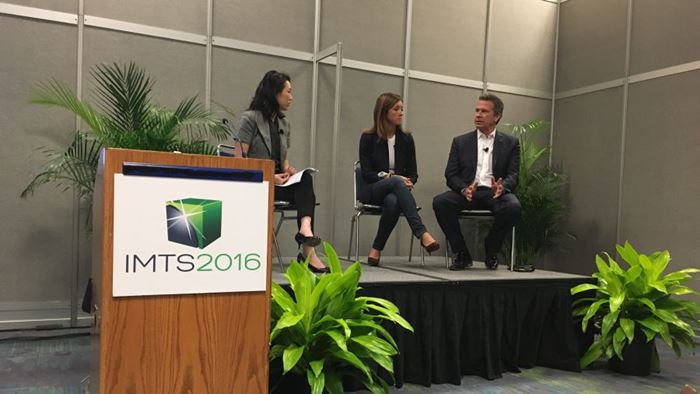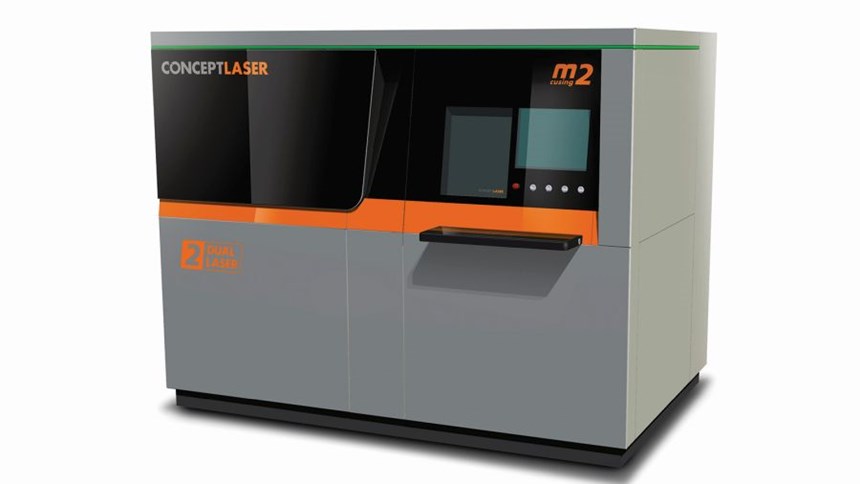rp+m Pursues R&D toward Additive for Production with Concept Laser Machine
rp+m elaborates on its adoption of powder-bed metal additive manufacturing technology.
Additive manufacturing service provider rp+m (Avon Lake, Ohio) and Concept Laser (Grapevine, Texas) held an interview-style event for the press at the International Manufacturing Technology Show (IMTS) elaborating on the former’s adoption of the latter’s M2 Cusing powder-bed-based metal additive technology. In conjunction with Concept President and CEO John Murray, rp+m President and CTO Dr. Tracy Albers related her company’s focus on research in additive manufacturing, especially as it is applied toward production, beyond just prototyping and short runs.
As company founder Matt Hlavin has previously described it for Additive Manufacturing, rp+m is interested in the long-term and difficult project of “tangible consulting,” offering advice to customers that also involves developing additive parts. As such, the company is interested in strategic partnerships in order not only to profit materially in new business, but also to further contribute to the industry’s progress toward more creative part production solutions.
According to the companies, Concept’s M2 Cusing laser melting system, featuring a 250 × 250 × 280-mm build envelope, will enable rp+m to continue doing just this sort of R&D through production. Dr. Albers explains the reasoning behind rp+m’s selection of this machine in a written release from August: “Our job is to find the right solution for our clients—and in many cases, that solution doesn’t yet exist. We need the ability to print with both reactive and non-reactive materials, develop proprietary alloys, and adjust parameters to produce the most efficient and effective parts for our customer base.” She says the M2 fits these requirements.
During the IMTS press event, Dr. Albers emphasized the need for critical thought in the effort to further AM development in production. The tendency of an engineering team is to be boastful about the solution rather than defining the problem well, she said. In light of the observation that most of the world’s innovations are to some degree serendipitous, she believes it’s important to ask “why”—what’s wrong with how you make the part today?—before resorting to an additive approach for other, perhaps less sound reasons.
As an example of this, Dr. Albers recounted how, when a customer once approached the rp+m about an automotive part usually made out of stamped sheet metal, she and her staff first challenged the idea of moving to an additive process for making the part, since it was so inexpensive to make as it was. In the end, rp+m was in fact able to help the customer reduce lead times—a benefit that may not be as impressive as some of the most touted part-related innovations making news among additive technology adopters and part designers, but one that arose from rp+m’s critical approach.
Related Content
-
VulcanForms Is Forging a New Model for Large-Scale Production (and It's More Than 3D Printing)
The MIT spinout leverages proprietary high-power laser powder bed fusion alongside machining in the context of digitized, cost-effective and “maniacally focused” production.
-
Large-Format “Cold” 3D Printing With Polypropylene and Polyethylene
Israeli startup Largix has developed a production solution that can 3D print PP and PE without melting them. Its first test? Custom tanks for chemical storage.
-
Multimaterial 3D Printing Enables Solid State Batteries
By combining different 3D printing processes and materials in a single layer, Sakuu’s Kavian platform can produce batteries for electric vehicles and other applications with twice the energy density and greater safety than traditional lithium-ion solutions.

















